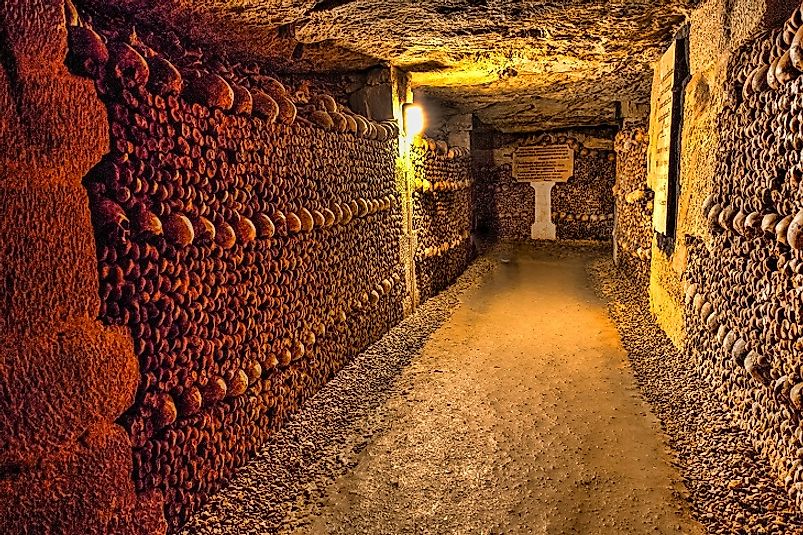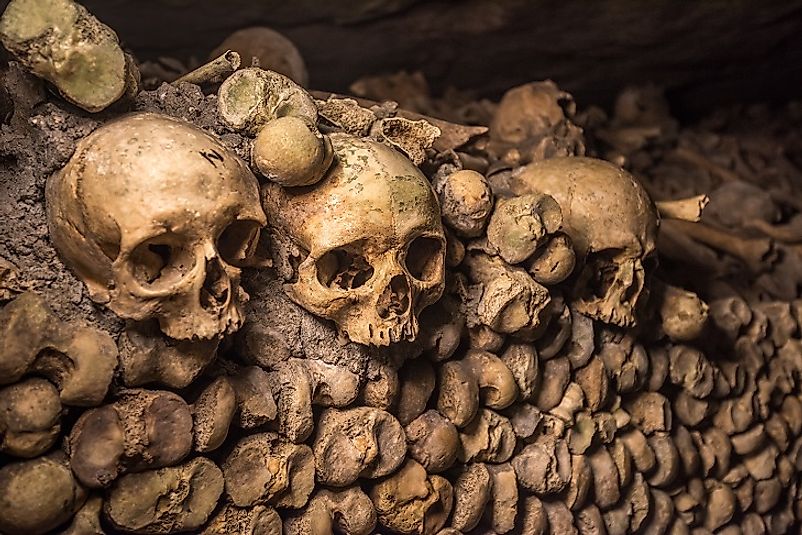Catacombs of Paris - Subterranean Boneyard Of France

5. Description and History
Hosting the skeletal remains of over 6 million individuals, the Catacombes de Paris, refers to the underground ossuaries located in a section of the Mines of Paris tunnel network. The catacombs can trace their origin to the limestone quarries of the past that yielded building material for the city’s buildings and played an important role in the growth and development of the city. The transformation of these quarries into ossuaries occurred during the late 18th Century. During this time, many of the cemeteries in Paris (like the Les Innocents cemetery) were overburdened with the remains of the dead, leading to constant complaints from people living near these cemeteries about stench from dead bodies and spread of diseases from these cemeteries. The situation was ignored by the government for some time but in 1780 when a long period of spring rain triggered the collapse of a wall of the cemetery, leading to the spilling of bodies onto an adjacent property, the government was forced to take action. Soon an alternative location for placing the dead bodies was found in the Tombe-Issoire quarries which was then blessed and consecrated. Bodies were transferred over a period of two years to the new location. Soon, this practice was carried out in case of other overburdened cemeteries in the city and after the French Revolution, new burials also started taking place in the underground tunnels, in what is today known as the Catacombs of Paris.
4. Tourism
The Catacombs of Paris have a tourism history dating back to the 18th Century with the first distinguished visitor being the Count of Artois in 1787. Later, the ossuary was opened to public after the 1814 to 1815 war. Though there were several concerns like the church’s opposition to the public display of sacred human remains, degradation of the ossuary by unscrupulous visitors and cases of vandalism, the high public demand of visiting the ossuary could not be ignored. Currently, visitors are allowed to tour the Catacombs whose entry is through a stairwell in the Barrière d’Enfer building. Not more than 200 simultaneous visitors are allowed at the Catacombs and those with a nervous disposition or heart and respiratory illnesses are also not advised to enter the ossuaries.
3. Uniqueness

The Catacombs of Paris have often been popularly regarded as the “World’s Largest Grave”. This ossuary holds centuries-old bones of Parisians arranged in intricate designs and patterns, an eerie yet unique sight for the visitors to the catacombs. The dark tunnels and underground deposits of human remains of millions of individuals are a stark contrast to the bright and glamorous city of Paris above ground.
2. Engineering and Architecture
Though the catacombs were originally an unorganized storage area of human bones, the creative genius of Louis-Étienne Héricart de Thury, a mining engineer heading the Mine Inspection Service, transformed the catacombs into a more well-arranged and visitor-friendly ossuary. Under his able directions, a massive renovation of the catacombs started in 1810 when the bones were arranged into specific patterns possessing aesthetic quality. The decorations used in the old cemeteries were also brought to the catacombs and used to decorate its walls and floors. To further encourage tourist interest in the property, a room displaying the minerals found in Paris and another one exhibiting the various types of skeletal deformities detected in some bones deposited at the ossuary, were established.
1. Threats
Though damaging the bones and other properties of the Catacombs of Paris is strictly against the law and those caught doing so are threatened with prosecution, it is believed that over 300 Cataphiles enter the Catacombs through secret routes every week. Cataphiles are defined as Parisian urban explorers who enter the Catacombs illegally. Only a small section of the Catacombs is open to public in a regulated manner but the large sections that are not, become a favorite haunt of these Cataphiles who visit these sites for either a simple interest in urban exploration or to hold strange parties or meet clandestinely.







